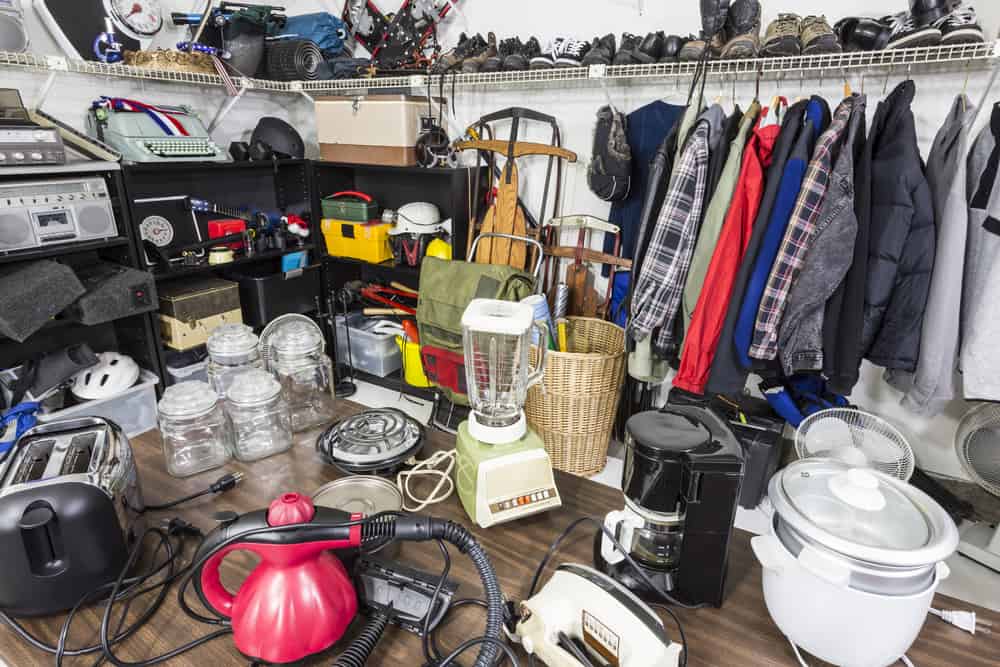Guest post by Garret Stembridge, Extra Space Storage
Whether you’re spring cleaning or just plain irritated enough to throw your clutter right in the gutter — hold up a minute! It’s now easier than ever to find a worthy charity to take the excess off your hands — and put it into the hands (or paws) of someone in need.
1. Gather everything you don’t want.

Here are three lists of the items most sought in popular charity sectors:
Homeless Shelters
- Food (especially items high in protein)
- Grocery/fast food coupons
- Toiletries
- Clothing
- Blankets/sleeping bags
- Rain gear/small umbrellas
- Backpacks
- Hand warmers
Resale/Thrift Stores

- Computers
- Computer accessories (printers, mice)
- Cellphones
- Clothing
- Housewares
- Books
Animal Shelters
- Blankets
- Plastic bags
- Cleaning supplies
- Batteries
- Heating pads
- Latex/rubber gloves
- Office supplies
- Baby food with meat
Contact your favorite local organizations to see what they need most. Perhaps there is a shortage of can openers right before your city’s homeless shelter is planning to hold a canned food drive, and you recently noticed you have somehow collected four of them in your “multipurpose” kitchen drawer?
Renovating your home?
Find out what your home's worth, edit facts, and see the impact of home projects.
2. Know that one man’s junk is another man’s … junk.
Renovating your home?
If your household items are trash to you, then they’re probably not useful to anyone. Would you be able to look a person in the eye and smile while handing them your busted curling iron? To help programs run efficiently, all donations should be gently used items in good working order.
But as you declutter your home, don’t toss items without considering their possible use. All kinds of parts can be harvested from broken computers and reused, through Dell’s Reconnect program, for example.
3. Shop around for the right charity.
It’s quite understandable to want to chuck every (gently used!) loose end in a garbage bag and ship it all off to a thrift store. But you can actually increase your philanthropic efficacy with just a dash more creativity.
Because there’s quite a bit of overlap in entities that accept in-kind donations, you have some decisions to make. Books, for example, can be donated to a variety of places, from your local school system to adult literacy classes to international library development.
So ask yourself: What causes are most important to you? Use an online database such as Charity Navigator to find specialized organizations near you. Consider and research programs at those organizations. Did you know, for instance, that The Salvation Army has a Missing Persons sector that locates an average of 350 people annually?
And some charities offer donation pickup service, which can make your contribution super convenient.
4. Have a fundraising garage sale.
If your heart belongs to a specific cause, throw a yard sale of your stockpiled bounty and donate the proceeds. For many charitable organizations, cash is king. In the case of most disaster relief, for example, specific items must be purchased near the site of need.
Looking to save money on your mortgage?
5. Do good, feel good.
Take a moment to feel kindly toward yourself. Hauling unwanted household items off and into a landfill is fast and easy, but it’s not helping anybody. It’s possible to be environmentally and socially conscious even while cleaning out your closets!
Consider the beneficiaries of a donation personally as individuals, families and communities working for a better future. Let this inform your commitment to the process and do it right.
And put a little sugar in your own cup and write off your donation in your taxes!
For your tax deduction, be sure to:
- Make a list of all the items you’re giving and the condition of each.
- Record each item’s value. Goodwill has valuation guides for commonly donated items. If your donation is brand new, such as with groceries, keep the receipt.
- Take a photo of your donation for your own records.
- Obtain a written receipt from the charity. This is required for donations of $250 or more.
- In cases of valuable donations — usually those worth more than $5,000 — an official appraisal is needed.
While there’s little known about the causes of “Chronic Clutter Syndrome,” one thing is certain: The medicine is just a small dose of casual philanthropy, and it is really quite habit-forming.
About Garret Stembridge and Extra Space Storage
Garret Stembridge is part of the team at Extra Space Storage, a leading provider of self-storage facilities. Garret often writes about storage and organization topics for homes and businesses.
Note: This is a guest post; the views and opinions expressed are those of the author and do not necessarily reflect the opinion or position of Redfin.


























 United States
United States Canada
Canada